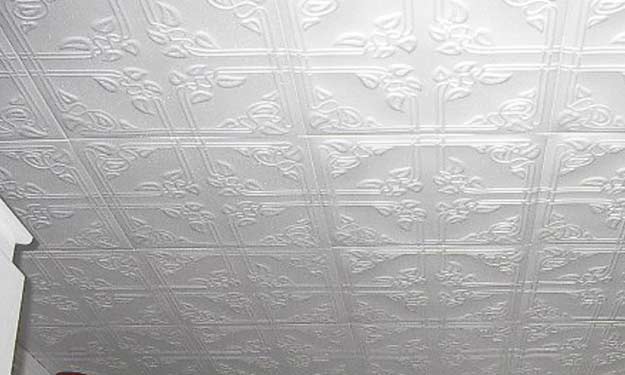How to Clean Ceiling Tiles

How to Clean Ceiling Tiles.
Cleaning and Removing Stains from Ceiling Tiles
When I first told my friends and family about my plan to install ceiling tiles in my new kitchen, the most common response was, “Why?”
Ceiling tiles today aren’t just the plain, white, square “popcorn” tiles in basements or offices anymore. There are endless possibilities with a wide variety of materials, designs, and colors to choose from.
At my local home improvement store, I found tiles that looked like wood planks, real silver, tin, copper, and even leather. They came in textured, raised, smooth, and ornately styled surfaces. I had difficulty choosing due to the large selection, so I went home with both faux wood and silver ceiling tiles. Everyone was surprised at how modern my home looked with the beautiful ceiling tiles.
Fast Forward 1 1/2 Years and Cleaning Ceiling Tiles
My ceiling tiles started looking a little dingy. That won’t do at Mrs. Clean’s home! The manufacturer’s instructions indicated that regular cleaning is necessary to keep the tiles looking as beautiful as when they were first installed.
The cleaning method depends on the material of the tiles, whether porous or sealed, and their texture. If you’re unsure about your ceiling tiles, a visual assessment can help determine the cleaning method.
If you’re behind on ceiling tile upkeep or have just installed new tiles and want to know how to clean them, read on. I’ve tested these methods and consulted experts to ensure these tips will get your tiles looking like new again.
How to Clean Porous Ceiling Tiles
Porous tiles, often acoustic (sound-absorbing) tiles, are found in many commercial buildings and older homes. They are not sealed.
Cleaning Porous Tiles
- Routine dusting or vacuuming with a soft brush attachment prevents cobwebs, dirt, and stains.
- Use a feather duster or quality static duster, paying special attention to corners and cobwebs.
- Avoid disposable dusting cloths as they can snag and make the tiles dirtier.
- A soft brush or dusting attachment on vacuum cleaners works well.
Removing Stains from Porous Tiles
- Use a dry sponge, available from janitorial suppliers, for spots and stains.
- If the stain is stubborn, you might need to replace the tile.
Non-Porous/Sealed White or Colored Ceiling Tiles
These tiles are sealed and often have intricate designs.
Cleaning Non-Porous Tiles
- Light dusting once a month with a soft, cotton dust mop, feather duster, or static duster.
- When tiles appear dull or dirty, use a mild solution of 1 TBL dishwashing liquid to 1 gallon of warm water and wipe gently with a soft cloth.
- Dry the tile completely with a clean terry cloth to restore shine and avoid streaks.
Removing Stains from Non-Porous Tiles
- Use the mild dishwashing liquid and water solution to remove any splatters.
Tin, Silver, Copper, or Wood Finished Ceiling Tiles
These tiles can have vinyl or PVC facings with finishes that look like metal, plaster, or decorative wood. They are usually waterproof and easy to clean.
The Cleaning Process
- Dust with a dust mop, feather duster, or static duster.
- Clean one tile at a time with a mild cleaning solution of 1 TBL dishwashing liquid to 1 gallon of warm water.
- Rinse the tile completely and dry with a clean terry cloth to avoid streaking.
- Use fine grade steel wool to gently remove any rust from tin tiles.
Popcorn Textured Ceiling Tiles or Panels
These are wallboard or sheet rock tiles that may be vinyl-coated or painted and sometimes sprayed with popcorn surfacing.
CAUTION: Popcorn ceilings prior to the late 1980s may contain asbestos. Have it tested by a professional lab before attempting to clean it.
Cleaning Popcorn Tiles
- Dust regularly with a feather duster, static duster, or vacuum attachment.
- Use a dry sponge for surfaces that should not get wet.
Popcorn Ceiling Stain Removal
- Stains are difficult to remove. Try using hydrogen peroxide to lighten the stain.
- Pour household strength 3% hydrogen peroxide into a spray bottle and lightly spray the stained area.
- Allow the solution to dry completely and reapply if necessary.
Avoid saturating the stain as this can cause the “popcorn” material to loosen and fall off the ceiling. When spraying the ceiling be careful of your eyes and contact with the hydrogen peroxide.
Popcorn ceilings can also be painted if you cannot get them cleaned and you don’t want to replace your ceiling.
Water Stains on Ceiling Tiles
Water stains typically result from a plumbing leak, roof leak, or another plumbing issue from the level above. Before addressing the stain, ensure the source of the leak is completely fixed.
If replacing the ceiling tiles isn’t possible and stains persist, consider painting the ceiling.
Before painting, apply a high-quality sealer. This will prevent stains from bleeding through the new paint and eliminate any associated odors, such as mildew.
Heavy Duty Stain Removal
- Mix 1/4 cup bleach with 1 quart of water in a spray bottle.
- Spray the solution on the stain without saturating the area.
- Let it dry and reapply if necessary.
This solution can also be used on painted ceiling tiles, but caution should be used as it might ruin the finish of tiles painted with flat latex paint. Always test in an inconspicuous place first.
Enjoy Your Clean Ceiling Tiles
Cleaning ceiling tiles adds to my to-do list, but I don’t mind because they make my home look great. I hope you’ll be just as satisfied with the results as I was.



